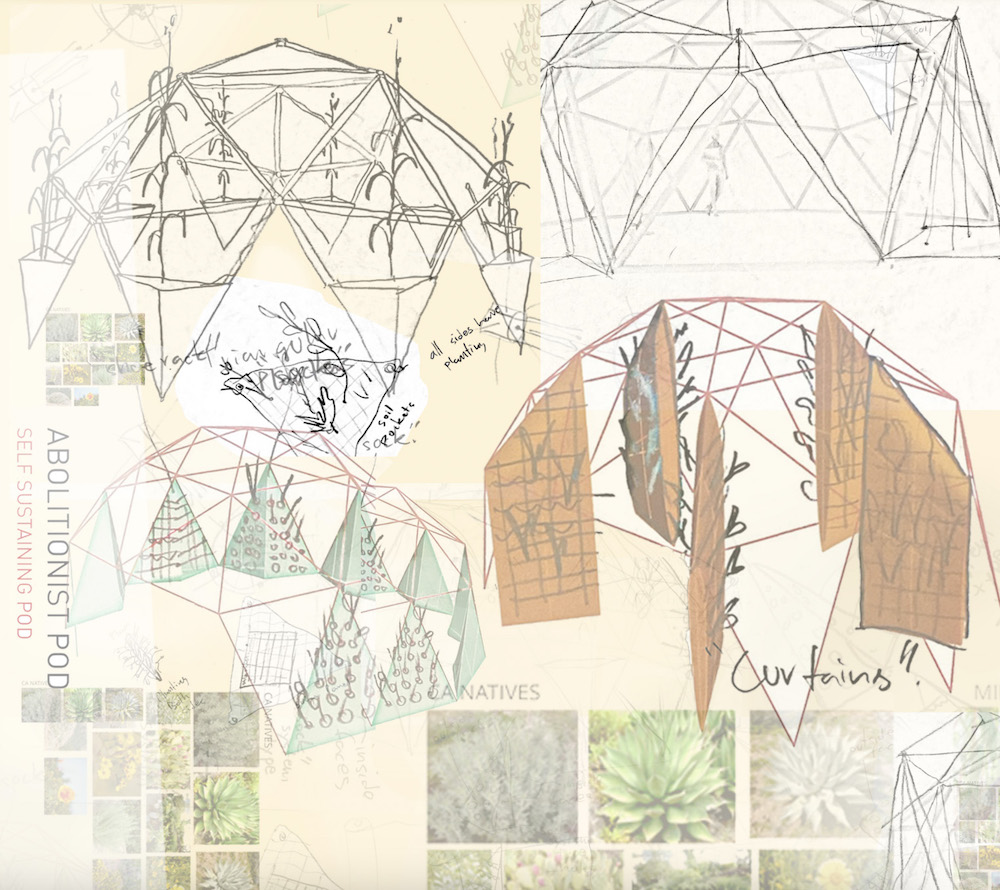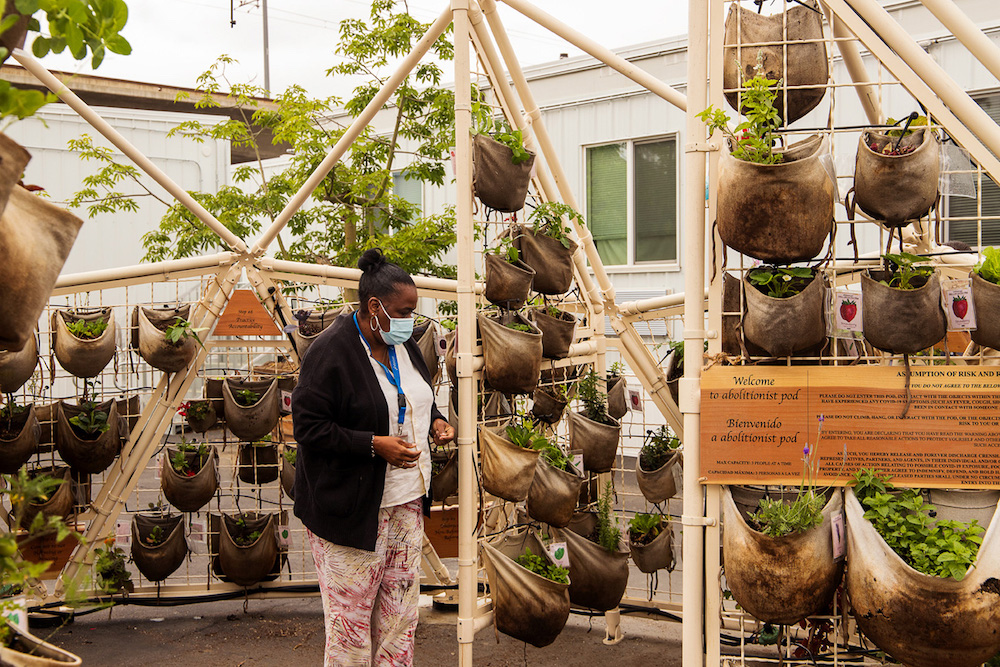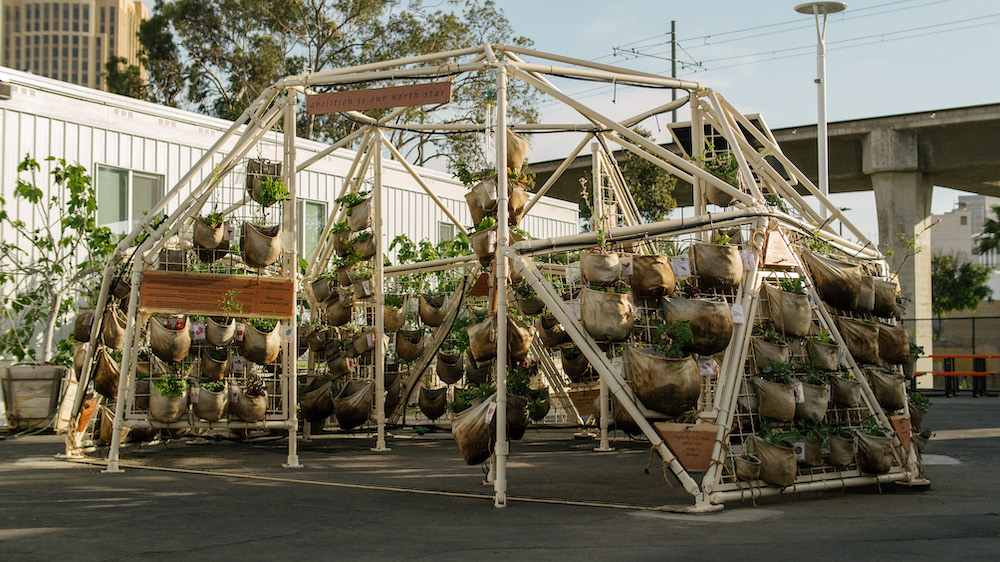The artist-of-color-led arts organization and collective in Inglewood, Crenshaw Dairy Mart (CDM), is continuing a legacy of Black-led art spaces in South Los Angeles. Co-founded by multi-hyphenate artists Patrisse Cullors, alexandre ali reza dorriz and noé olivas, it has been operating largely under the radar since its inception in 2020. As the kids say, “If you know, you know.”
The art world’s awareness of CDM, its mission and programming—all orbiting around the radical concept of abolitionist aesthetics, defined by Cullors and dorriz in a UCLA Law Review paper as the “contemporary artistic movement where artists, collectives and organizations have employed the arts to address abolition of the prison-industrial complex toward an effective social and political change”—has been a slow burn.
But, after successfully self-advocating to be included in the third iteration of the Getty Foundation’s epic PST art program, CDM is officially a pre-
vetted, card-carrying contributor to the “in-the-know” art world. I spoke over the phone with dorriz, olivas and Programming Director Vic Quintanar, to learn more about their program.
The two prongs of the prison-industrial complex abolition movement—or simply, abolition—are the removal of harmful systems and the imagining of alternatives to those systems, such as mutual aid, liberation and rehabilitation. CDM’s exhibition “Free the Land! Free the People!” will present the evolution of abolitionist pod (2021–ongoing): geodesic-domed modular standing-garden installations that reimagine community care and other tenets of abolition, such as the capacity to resist capitalism through autonomy and reconnecting with the earth.
The prototype abolitionist pod was created during the height of the COVID-19 lockdown, when hospitalizations and food insecurity were at record highs. The co-founders saw an opportunity to imagine a new way forward. “What would this have looked like if we lived in abolitionist mainframe?” said dorriz.

Crenshaw Dairy Mart abolitionist pod (prototype) Drawings and Digital Renderings, 2021. Courtesy of the Crenshaw Dairy Mart.
When The Museum of Contemporary Art (MOCA) invited CDM to be its partner for the 2021 “We Rise” project focusing on mental health, the CDM team began brainstorming how to manifest the tenets of abolition visually and engage community meaningfully and safely. How could they leverage abolitionist aesthetics to counter a food apartheid that, noted dorriz, already “existed in the ether and was exacerbated by the pandemic, by systems within capitalism?” More importantly, how would they convince the museum to provide security trained to de-escalate, rather than calling in the police? “MOCA was concerned about people climbing or damaging” the abolitionist pod (prototype) (2021) during episodes of mental illness, recalls olivas, as the pod would be installed publicly outside MOCA Geffen. They said, “‘We’ll need to call the LAPD.’ We were like, ‘No, the structure doesn’t matter, we care about people.’” CDM included language in their agreement with MOCA that they would hire their own security. “I wouldn’t even call them security, I would call them caretakers, to be honest,” said olivas. And thus, an abolitionist security template for future partnerships was established.
Olivas, who has a background in architecture, took the lead in designing the prototype pod, inspired by R. Buckminster Fuller’s seminal dome design and the ’90s film Bio-Dome. The pod was made with such natural materials as bamboo and hemp planter bags. “It was a 20-foot-in-diameter community fridge,” dorriz told me, that featured yoga, meditation, plant swaps and fireside chats.
The prototype pod’s materials had room for improvement, and a second pod was designed with more durable yet sustainable resources to be permanently installed at the Hilda L. Solis Care First Village. The property in downtown LA, “in the shadow” of Men’s Central Jail, was originally acquired to expand the jail. But community organizers and LA County Board of Supervisors Chair Hilda L. Solis stepped in to stop the plan and successfully advocated to instead provide 232 units of transitional housing for formerly incarcerated, system-impacted and unhoused individuals. CDM co-developed trauma-informed curriculum for the Hilda L. Solis Care First Village abolitionist pod (2022–ongoing) with Huma House, Community Services Unlimited, Dignity and Power Now, and Creative Acts. This was abolition, in action.

Crenshaw Dairy Mart abolitionist pod at the Hilda L. Solis Care First Village in Chinatown, Los Angeles, CA. 2022. Documentation by Star Montana. Courtesy of the Crenshaw Dairy Mart.Crenshaw Dairy Mart abolitionist pod at the Hilda L. Solis Care First Village in Chinatown, Los Angeles, CA. 2022. Documentation by Star Montana. Courtesy of the Crenshaw Dairy Mart.
To frame the project within the scope of PST’s Art & Science Collide, dorriz said, “We’re pulling at the threads of abolition as a scientific discourse.” Olivas continued, “How can we look at abolition as a scientific finding? How can we study that as a collective and communicate that?”
“So much of abolitionist discourse is about prototyping …” said dorriz. “Imagination is a scientific process. Things are going to fail; things are going to work out.”
The prototype pod will be open to the public during regular operating hours at CDM and will be activated with three special days of programming, “each associated with a tenet of our mission,” said Quintanar, “First abolition, then ancestry, then healing.” The abolitionist pod is “a space that opens you up,” said Quintanar. They hope folks will experience it as they do, as a reminder of what we can co-create when “you build the skills to trust people—not just structurally and physically, but internally. The pod, for me, is a big symbol of healing.”


